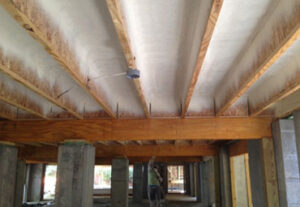Insulation for Rutledge, GA Crawlspaces and Basements
Rectangular-shaped holes that penetrate oval or round vents from the crawl space of your home is a common and burdening situation for homeowners, even if you have batt insulation installed. Since batt insulation is unable to create a vapor/air barrier, it cannot contain contaminated, warm, or cold air, from entering your home through the crawl space.
The living space of your home can be infiltrated with mold, earth gases, rodents and other allergens if your crawl space is not properly sealed.
 The only material that can achieve a full seal is spray foam insulation. In order to accomplish an effective thermal barrier from obstructions like ductwork, plumbing, wide/narrow joist spacing, and plumbing, spray foam insulation must be applied between the floor joists of your crawl space.
The only material that can achieve a full seal is spray foam insulation. In order to accomplish an effective thermal barrier from obstructions like ductwork, plumbing, wide/narrow joist spacing, and plumbing, spray foam insulation must be applied between the floor joists of your crawl space.
Due to the use of wire insulation hangers, fiberglass insulation can often be compressed when it is applied. Insulating open web floor trusses properly with fiberglass is nearly impossible since air can move inside the fiberglass. This is because open web floor trusses can generate pathways of air.
Mold, condensation, and a decaying floor system are all generated during the summer, when warm and humid air flows around the fiberglass insulation.
A proper and effective barrier for vapor infiltration between the ground and homes subfloor surface is closed-cell spray foam insulation. Closed-cell spray foam stops any vapor or air from moving into the home’s walls or attic space, eliminating any problems that could be caused by the “stack effect.”
Floor insulation problems are reduced, since spray foam completely fills open spaces and voids. Spray foam, unlike fiberglass, fills the open webs of full trusses completely, and creates a complete and uniform thermal barrier on the floor, as it also fills all areas around the wiring and plumbing.
Overcoming several disadvantages that other insulation products can bring to the table, spray foam insulation is the superior product when it comes to insulating your crawl space.
A more consistent and uniform thermal barrier that contains air flow/stack effect retarding functions is produced with the application of spray foam.
Crawl space insulation has a much bigger impact on a home’s energy efficiency than most people realize. Unlike a basement, that has both headroom and fairly easy access, a typical crawl space can be difficult to get into.
This is the main reason why crawl space insulation is often overlooked when people are aiming to improve energy efficiency and reduce heating and cooling problems. Insulating a crawl space with spray polyurethane foam can be beneficial for residential and commercial structures. On top of superlative insulation, spray foam creates an air barrier and moisture barrier for all leakage and infiltration coming in through the structure’s band joists
Properly Insulating and Sealing Your Crawl Space
Crawlspaces can be insulated two ways: insulating the ceiling for a vented crawlspace or insulating the walls for an unvented crawlspace. Spray foam insulation can be effectively utilized in both ways to help address common problems associated with uninsulated or poorly insulated crawlspaces.
A properly insulated and sealed crawl space is one of the fundamental elements of a comfortable, healthy home. Crawl spaces have long been insulated with fiberglass batt insulation, but modern building science reveals the downsides of that practice. Ideally, crawl spaces should prevent air from infiltrating a home, so as to reduce drafts and improve air quality. Spray foam insulation can provide a more uniform, consistent thermal barrier as well as provide an air and moisture barrier.
Problems with Fiberglass
Fiberglass batt insulation cannot control or prevent the movement of air or moisture because it is a porous material. So even if your crawl space is supposedly properly insulated with batts, they will not prevent air from leaking out of or infiltrating the living space of your home. If the crawl space in your home is not fully sealed, there is a strong likelihood that airborne contaminants, mold, rodents, and more can enter your living space.
Batt insulation is often compressed during installation due to the use of wire insulation hangers. Open web floor trusses create additional problems such that they create pathways for air to move around the batts. During the summer, warm and humid air can flow around the batts and create condensation, mold and decay problems in the floor system. Open web floor trusses are virtually impossible to adequately insulate and seal with batt insulation.
The Spray Foam Solution
Spray foam insulation in the crawl space is a superior insulation product that overcomes several disadvantages of other insulation products. Spray foam circumvents typical insulation problems through its ability to completely fill voids and open spaces, resulting in a complete, essentially uniform thermal barrier.
Spray foam insulation installed between your floor joists in your crawl space is the only material that will create an effective thermal barrier from penetrations like wiring, plumbing, ductwork, and imperfect joist spacing. Closed-cell spray foam will also serve as an effective moisture barrier between the ground and a home’s subfloor surface. Controlling the presence of moisture in a home is critical to preventing the potential for mold growth.
A completely sealed and unvented crawl space can provide a variety of benefits for homeowners. Here are some of the most significant benefits:
-
- Improved Indoor Air Quality: By sealing the crawl space, you can prevent moisture and air from entering the home. This can reduce the risk of mold growth and improve the overall air quality of the home. Improved indoor air quality can lead to better respiratory health and overall well-being for the occupants.
- Energy Savings: A sealed and unvented crawl space can reduce the amount of energy required to heat and cool a home. By preventing air leakage, the heating and cooling system can work more efficiently, leading to lower energy bills and increased energy savings over time.
- Increased Home Comfort: A sealed and unvented crawl space can help maintain a consistent temperature throughout the home. By reducing the workload on the heating and cooling system, the home can stay comfortable year-round, regardless of the outdoor temperature.
- Pest Control: A sealed and unvented crawl space can help prevent pests from entering the home. By sealing off entry points, pests like rodents and insects are less likely to find their way inside.
- Structural Integrity: By sealing the crawl space, you can help prevent moisture from damaging the foundation and structural elements of the home. This can help extend the lifespan of the home and reduce the need for costly repairs.
Overall, a completely sealed and unvented crawl space can provide numerous benefits for homeowners. If you’re considering this type of crawl space encapsulation, it’s important to work with a qualified professional who can help you choose the right insulation material and ensure proper installation.
